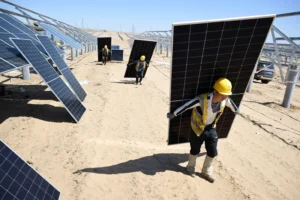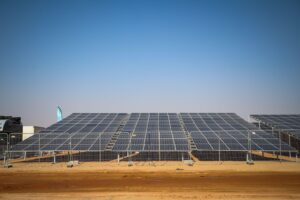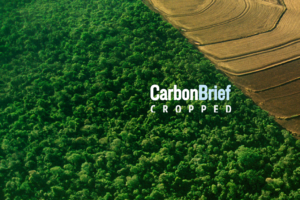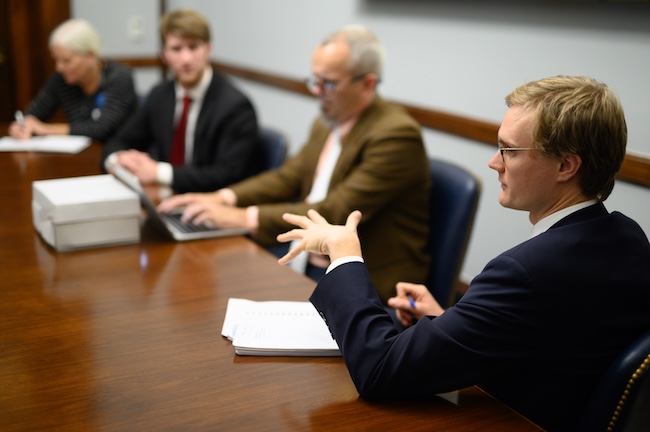尽管中国电力需求快速增长,但清洁能源发电的增长首次使该国的二氧化碳(CO2)排放量出现下降。
Carbon Brief的最新分析显示,2025年第一季度,中国的碳排放量同比下降了1.6%,过去12个月则下降了1%。
新增风电、太阳能和核电的装机容量所带来的出力,足以应对电力需求激增,从而削减燃煤发电量;而此前的排放下降则主要被归因于经济增长放缓。
这项基于官方数据和商业数据的分析显示,中国的碳排放量一年多来一直保持稳定或下降。
不过,该排放量仅比最近的峰值低1%,这意味着只要出现短期反弹,中国的碳排放就可能创下新高。
其他主要发现包括:
- 清洁能源发电增长速度已经超过当前及长期电力需求增长平均值,从而压低了化石燃料的使用量。
- 截至2025年3月的12个月内,电力行业的碳排放同比下降了2%。
- 若这一趋势得以保持,意味着中国电力行业排放可能已达峰并开始持续下降。
- 美国总统特朗普发动的“贸易战”促使中国更加努力将经济重心从出口转向内需。
- 新出台的可再生能源电价政策催生了“抢装潮”,企业争相在政策实施前完成项目建设。
- 如果中国要实现在《巴黎协定》下承诺的2030年排放目标,仍面临日益扩大的差距需要弥补。

如果这种因清洁能源增长而带来的电力行业碳排放下降趋势得以延续,可能预示着Carbon Brief此前在分析中预测的结构性排放下降的开始。
电力行业碳排放下降的趋势很可能在2025年继续。
然而,未来的走势在很大程度上将取决于中国即将于明年公布的下一份五年规划中所设定的清洁能源与减排目标,以及中国对特朗普政府敌对贸易政策的应对策略。
中国碳排放因清洁能源而下降
过去十年来,尽管中国化石燃料和水泥行业的碳排放量有高低起伏,但总体上升了20%。
最新数据显示,该排放量可能已经接近达峰以及趋稳,甚至正步入结构性下降的阶段。
截至2025年第一季度的最新数据显示,中国的碳排放量已经连续一年多呈现稳定或下降趋势,如下图所示。
不过,由于该排放量仅比最近的峰值低1%,这意味着其仍有可能在短期内反弹并创下新高。
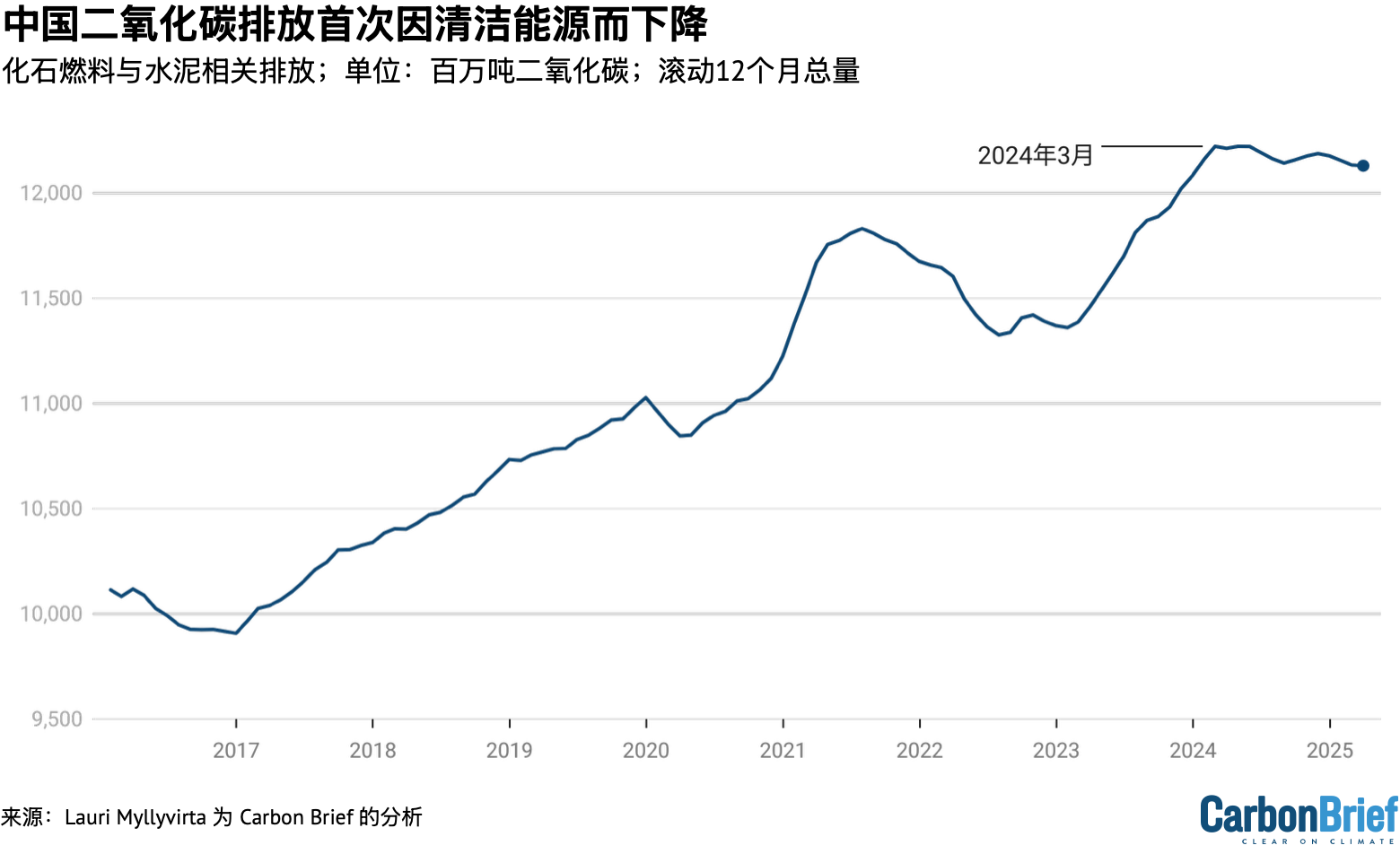
因此,中国未来的碳排放走向尚未确定,这取决于各经济部门的趋势,以及中国对特朗普关税政策的应对方式。
电力行业排放下降,其它行业却现反弹
2025年第一季度中国碳排放的下降主要源于电力行业排放下降了5.8%。尽管整体电力需求增长了2.5%,但火电(主要是燃煤和燃气发电)却减少了4.7%。
由于大量新建风电、太阳能和核电装机投入运行,发电量的增长足以弥补需求的增长。水电发电量也有所上升,虽然其受季节因素影响,但同样对化石能源的替代发挥了作用。
电力行业碳排放降幅超过化石能源发电量降幅,因为生物质和天然气的占比上升,同时燃煤电厂的平均能效也有所提升。
具体而言,燃煤电厂度电煤耗平均下降了0.9%。
下图底部显示了第一季度电力行业煤炭使用造成的碳排放量减少情况,该数据低于其他行业的碳排放量变化。
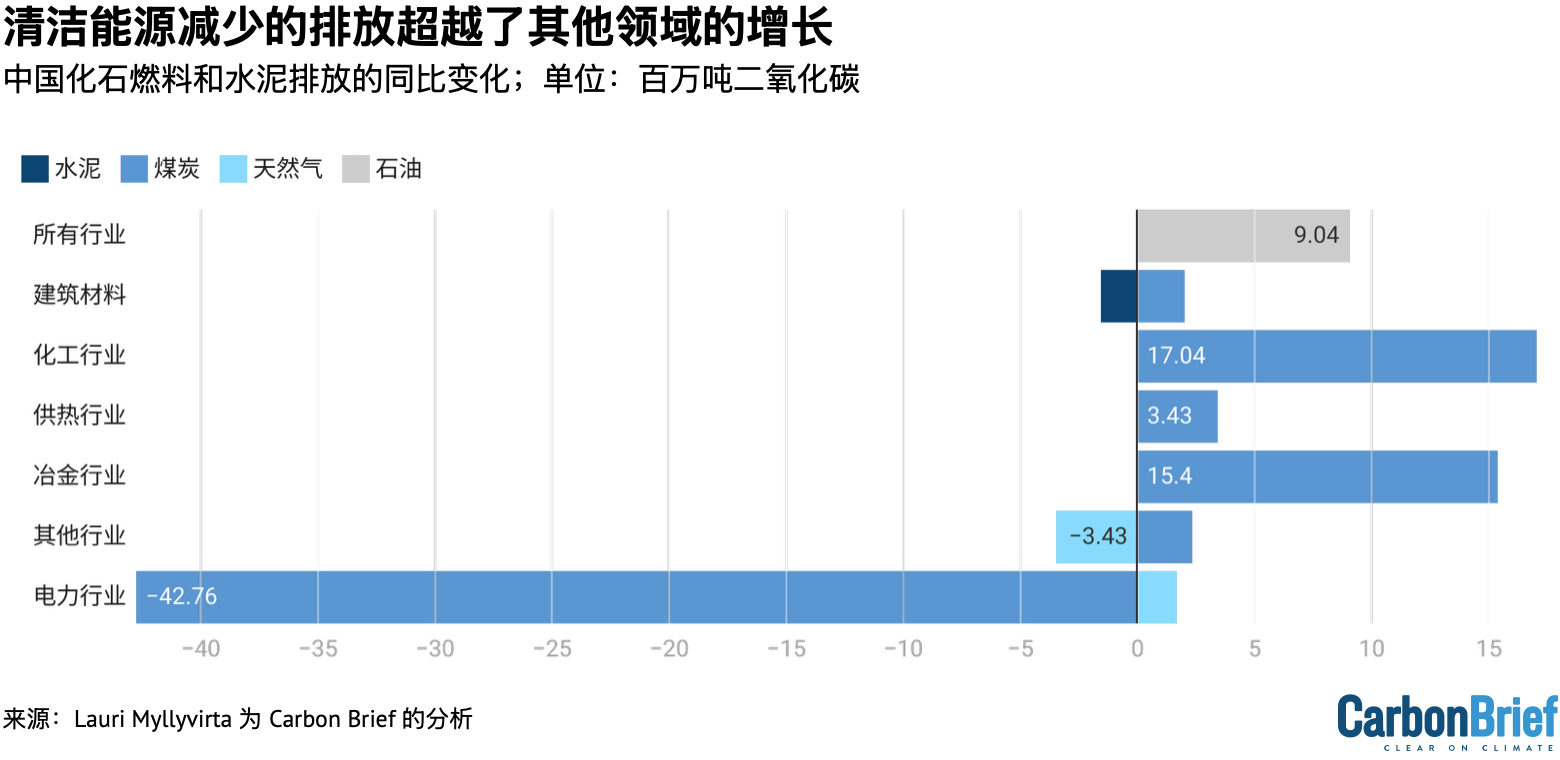
而在电力行业之外,碳排放量增长了3.5%,其中以金属和化工行业的煤炭使用增幅最大。
煤制化工产业正在快速扩张,背后的推动力包括对进口油气依赖的担忧。2025年第一季度,由于煤价走低而油价偏高,该产业的经济性更具吸引力。
粗钢产量同比增长了0.6%,金属制品增长6%,有色金属产量增长2%。这些增长主要集中在3月份,企业赶在关税生效前集中出口,带动金属需求激增,而高产出一直持续到4月。
房地产开工量同比下降24%,新房销售下降3%,反映出建筑行业对水泥、钢材和玻璃的需求持续疲软。
相比之下,汽车和机械制造的经济产出分别增长了12%和13%,表明对金属的需求正在上升。
水泥产量同比下降1.4%,降幅低于往年,可能是由于气温偏高使得依赖天气的施工活动提前启动。
由于燃气发电装机容量增长14%,尽管燃气发电的平均利用率下降,但电力行业的天然气消费量估计增长了6%。但在其他行业,天然气消费减少,总体上抵消了电力行业天然气需求量的增长。
石油制品消费略有上升,如图中最上方所示。由于天气偏暖,依赖天气的施工和农业活动与往年相比提前开工。
然而,从结构性角度来看,汽车电动化和货运行业改用液化天然气,预示着石油需求将持续走低。
中国是否已经碳达峰?
在2025年第一季度排放量同比下降1.6%之际,中国的碳排放自2024年3月以来已连续一年多保持平稳或下降态势。
然而,截至2025年3月底的12个月内,排放量仅比近期峰值下降了1%,这意味着只要出现短期反弹,排放量就可能再创新高。
继一季度大幅下降后,电力行业过去12个月的排放量同比也出现下滑。
在过去40年里,这种情况曾经发生过四次——分别是在2009年、2012年、2015年和2022年。但此次下降首次主要得益于清洁能源发电的增长。

2025年一季度清洁能源发电增速不仅超过整体用电需求增长,也高于过去15年电力需求的平均增长,如上图虚线所示。
此外,过去六个月水电发电量同比保持稳定,这意味着这轮清洁能源的增长是由太阳能、风能和核电装机容量的增长所推动的,而非水电的逐年波动所致。
除发电行业外,2024年12月到2025年3月期间,各行业碳排放均有所下降,但煤化工是个例外。
要使中国整体碳排放量达峰并开始下降,各下降行业的减排总量需超过仍在增长行业的排放增量。
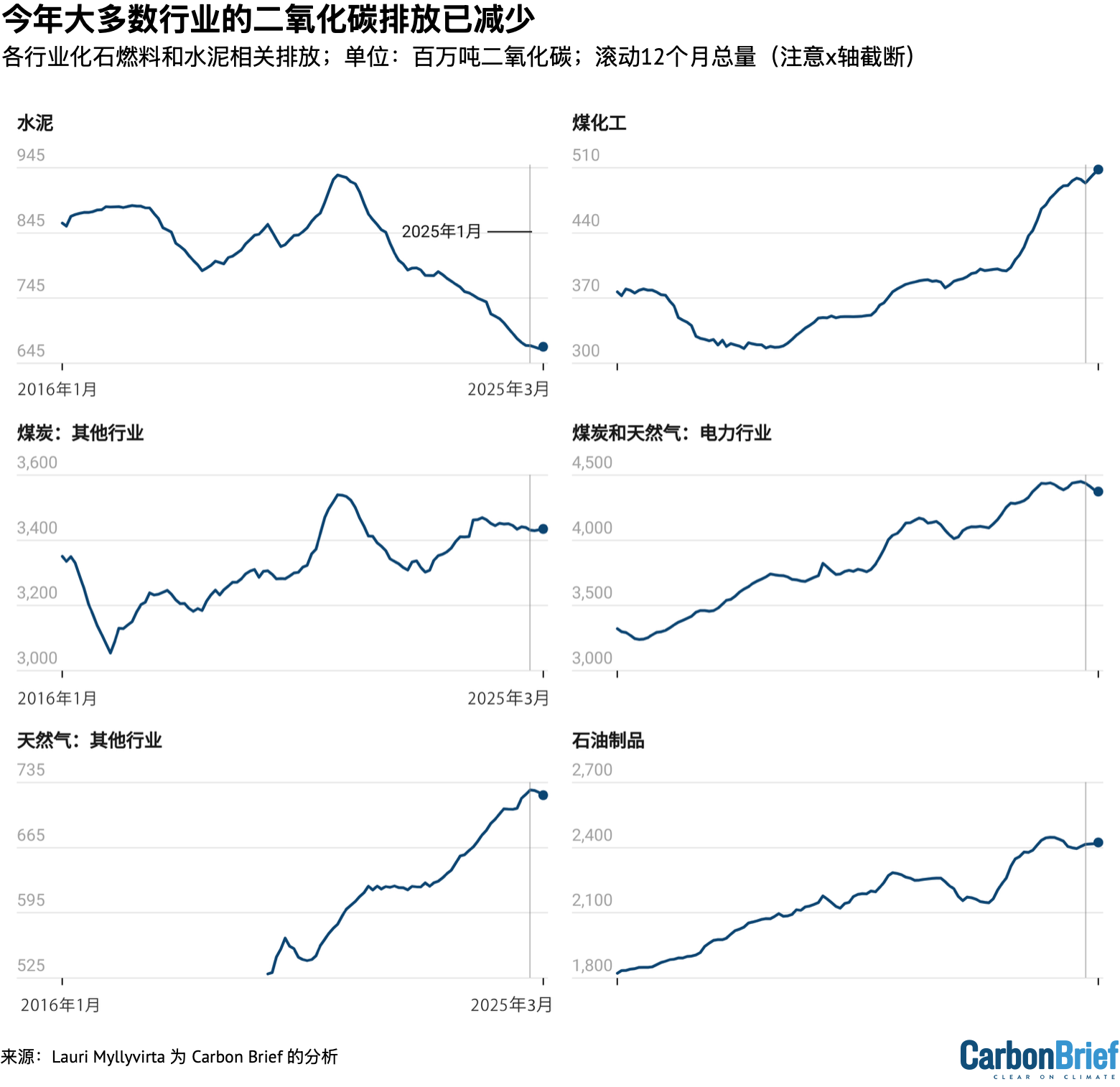
电力和化工以外的煤炭使用量与水泥行业同时达峰,但此后一直在反弹,目前已接近之前的峰值水平。
中国煤炭工业协会预计,钢铁和建材行业的煤炭使用量将下降,而化工行业的煤炭消费量将继续增长。
对煤炭未来需求增长的预期主要集中在化工行业,这也代表着煤炭从单纯的燃料向燃料和原料双重角色的转变。
该协会还认为,燃煤发电将至少在短期内恢复增长,但他们已将2025年的预测下调,与2024年底的展望相比有所保守。
“关税战”可能影响了预期。有分析指出,如果中国GDP因关税下降0.5到1个百分点,可能导致主要用于发电站的燃煤需求也出现类似的下降。
疫情后经济反弹到2024年3月结束,石油产品的消费量自此下降,较峰值减少了2%。尽管化工和航空领域的需求在上升,但由于交通运输领域电气化趋势增强,预计其长期仍呈下降趋势。
天然气的使用量近几个月有所下降,但总体趋势仍可能保持上升。
下表列出了每个行业在12 个月周期内的最高排放量,以及自最新峰值以来的减排量。

除了水泥生产之外,其他行业目前还不能明确判断是否已达排放峰值。然而,有迹象表明,其他行业的峰值也可能已经过去。
诚然,对于石油产品消费和钢铁生产而言,行业预测表明未来排放趋势可能会下降。
对于电力行业而言,只要新增清洁能源装机容量维持在当前或更高水平,就有望带来结构性的排放峰值——因为清洁能源的增长足以覆盖新增的电力需求。
这些行业碳排放量合计占全国八成以上。若这些行业均进入结构性下降阶段,那么中国碳排放总量很可能将开启持续下降通道。
中国推动内需应对美国关税
特朗普政府实施的史无前例的贸易关税政策,以及中国的反制措施,将影响今年及未来中国的经济和碳排放前景。
关税措施实施后,首当其冲的是中国沿海出口大省的工厂减产,从而导致排放下降,同时也可能波及投资和消费支出。
但因双方随后达成90天休战协议,反而刺激美国订单短期内激增,以弥补短暂的贸易放缓,并在休战结束前囤积商品。
中国对关税的反应主要集中在通过刺激措施抵消其经济影响。
虽然暂时的休战会降低出台刺激政策的紧迫性,但当前美国对中国的平均关税税率仍高达40%,远高于特朗普上台前的水平,因此中国领导层也很可能在为未来再次加征关税做好准备。
中国的重点将是为那些原本出口至美国的产品开拓国内市场。这一转向或将助力中国实现长期以来所希望推动的经济向消费驱动型增长转型,而成功实现经济再平衡,有望带来更低能耗的经济增长。
中国的应对措施还包括加大对“新质生产力”的重视,该概念强调新兴科技的发展。
这一概念涵盖了清洁能源产业,该产业如今已成为中国经济的重要引擎,因此难以在刺激计划中被忽视。
中国发改委最新公布的低碳示范项目清单,明确了清洁能源投资的重点方向。绿氢、储能、“虚拟电厂”以及基于氢能的工业脱碳是新的增长领域。
从碳排放角度来看,中国对特朗普关税的反应最关键的问题在于:针对这些优先领域(包括新兴的低碳领域及其他清洁能源产业)的刺激措施,是否足够有力。
新风光电价政策加剧不确定性
中国碳排放面临的另一个不确定性来源,是即将于今年6月生效的新可再生能源电力电价政策。
新政策取消了与煤电价格挂钩的价格保障机制,要求新的风电和太阳能发电项目与购电方直接签订电力合同。这可能导致新建风电和太阳能发电项目的售电价格下降。
不过,政策也为满足中央政府能源目标所需的新增装机容量提供了更有利的价格机制——“差价结算”。
该政策的直接影响可能是大量项目争相在6月前完成投产,以确保能够按现行政策享有机制电价。
其效果已经体现在最新数据中:仅 3 月份中国就增加了 23 吉瓦 (GW) 的太阳能和13GW的风能,比该月之前的新增太阳能和新增风能的最高记录高出80%和110%。
下图根据不同的预测显示,预计2025年和2026年新增清洁能源发电量仍将高于去年创纪录的水平。
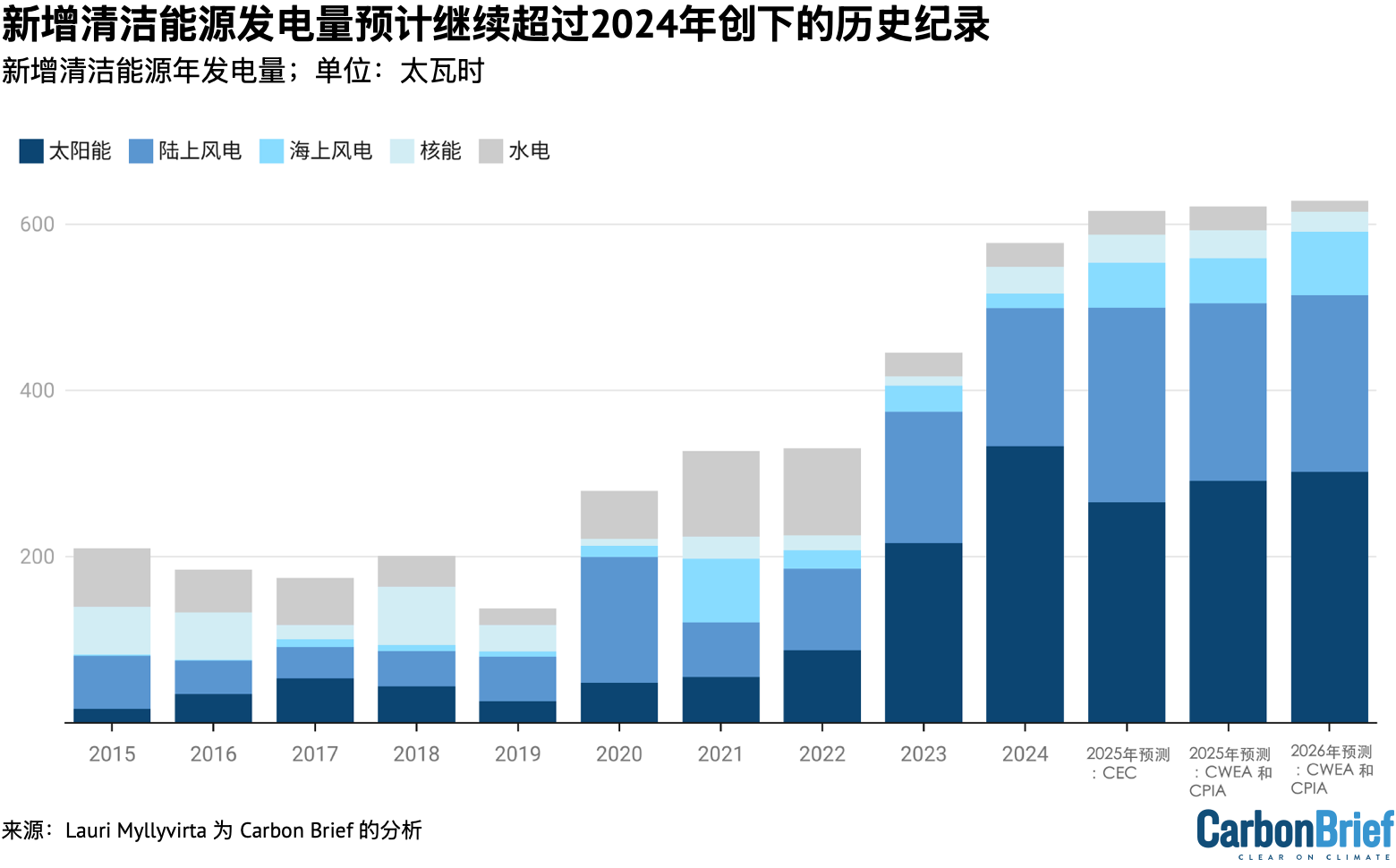
然而,这一政策也带来了更大的不确定性。一些行业,尤其是分布式光伏,将经历上半年装机量的激增而下半年放缓的艰难时期。
不确定性主要集中在两个方面。首先是地方如何执行这一政策,因为省级政府拥有相当大的回旋余地。考虑到清洁能源对许多省份经济的重要性,预计地方政府会力求以尽量不扰乱行业的方式来落实政策。
第二个不确定性来自中央政府的能源目标。新电价政策将更优惠的价格与中央政府的能源目标挂钩。而在过去几年中,清洁能源增长远远超过了官方设定的目标。
这凸显了即将出台的“十四五”规划中能源目标的关键作用。国家能源局设定的目标是“年均新增2亿千瓦(200吉瓦)以上新能源的合理消纳利用”,这一数字远低于去年实际新增的360吉瓦。
当然,电价政策的最终效果也取决于市场环境。当前中国煤电项目仍在快速上马,存在产能过剩风险。
中国与巴黎承诺之间的差距扩大
中国风电光伏发展面临的不确定性,也对该国履行《巴黎协定》下的国际气候承诺带来影响。
2020-2023年碳强度(即单位经济产出的排放量)下降进度明显滞后,中国已经明显偏离实现其2030年碳强度承诺的路径,几乎可以肯定将无法实现2025年的阶段性目标。2024年中国的碳强度下降了3.4%,未达到实现2025年和2030年目标所需的改善速度。
2025年政府工作计划中并未设定碳强度目标,仅包含单位国内生产总值能耗降幅超过3%(不包括原材料消耗)的目标。
这可以间接反映碳强度的改善幅度。2024年,中国的碳强度下降了3.4%,而化石能源使用强度下降了3.8%。如果2025年两者之间的比例相似,那么碳强度可能只能下降大约2.5%。在这种情况下,如果GDP增长达到5%的目标,碳排放量仍可能上升超过2%。
政府工作计划中没有设定碳强度目标,也没有特别强调碳强度的下降,显示出当局当前并未将实现这一目标作为优先事项。
政府工作报告中强调了“双碳”目标,即在2030年前实现碳达峰、2060年前实现碳中和。
然而,按照这些目标,2030年前碳排放仍可继续增长。这意味着到该年度,绝对排放量可能在2024年的水平上大幅增加。因此,即便“双碳”目标得以实现,也不能确保中国当前最核心的国际气候承诺——2030年碳强度目标——能够兑现。
即便今年碳排放有所下降,未来五年也需要大幅加快碳强度改善步伐,才能兑现中国2030年《巴黎协定》承诺。
如果中国仍然致力于兑现2030年承诺,那么该过程就需要体现在下一个五年规划设定的目标中。
2025年及未来展望
过去12个月可能标志着中国二氧化碳排放的一个重要转折点:清洁能源的增长首次超过电力需求增长,并在电力领域取代了化石燃料的使用。
尽管新的电价政策带来了一定的不确定性,但预计2025年仍将迎来创纪录的清洁能源新增装机容量,这表明这种趋势将在今年持续。
中国碳排放的未来长期走势将在很大程度上取决于即将出台的五年规划中设定的目标,以及北京应对美国关税和其他经济压力所采取的政策。
从短期看,美国加征关税将抑制能源需求增长和排放水平。为抵消特朗普关税影响而制定的经济政策,很可能会进一步推动清洁能源产业的发展,并可能促使经济重心转向国内消费,这意味着能源消费的增长将相对于GDP增长更少。
但另一方面,中国此前的经济刺激措施往往伴随着排放的急剧上升。中国若想转向消费和新技术驱动的刺激政策,而非高碳排的基建重工业,就必须突破传统发展模式。
电力行业的排放是否已经达峰,将取决于清洁能源供应增长与总体电力需求增长之间的竞赛。
按行业来看,除了电力行业,建筑材料、钢铁以及石油制品消费等领域的排放也可能已经达峰。
这些行业合计占中国与化石燃料相关碳排放的80%以上。然而,在所有这些行业中,都存在短期反弹的可能和不确定性。
目前仍有较大排放增长潜力的行业是煤化工。美国加征关税后国际油价的下跌将削弱该行业的盈利能力,可能导致即便新增产能增加,其工厂利用率也将下降。中国对自美国进口石化产品征收的报复性关税本可能本可能使煤化工行业受益,但这些关税据报已被豁免。
总体而言,这些因素可能推动中国未来五年排放持续下降,并有望在未来五年内实现大幅绝对减排。
然而,若政策出现转向,也同样可能导致碳排放在通往2030年的过程中继续上升。
The post 分析:清洁能源首次助力中国碳排放下降 appeared first on Carbon Brief.
https://www.carbonbrief.org/translations-analysis-clean-energy-just-put-chinas-co2-emissions-into-reverse-for-first-time/
Greenhouse Gases
DeBriefed 15 August 2025: Raging wildfires; Xi’s priorities; Factchecking the Trump climate report
Welcome to Carbon Brief’s DeBriefed.
An essential guide to the week’s key developments relating to climate change.
This week
Blazing heat hits Europe
FANNING THE FLAMES: Wildfires “fanned by a heatwave and strong winds” caused havoc across southern Europe, Reuters reported. It added: “Fire has affected nearly 440,000 hectares (1,700 square miles) in the eurozone so far in 2025, double the average for the same period of the year since 2006.” Extreme heat is “breaking temperature records across Europe”, the Guardian said, with several countries reporting readings of around 40C.
HUMAN TOLL: At least three people have died in the wildfires erupting across Spain, Turkey and Albania, France24 said, adding that the fires have “displaced thousands in Greece and Albania”. Le Monde reported that a child in Italy “died of heatstroke”, while thousands were evacuated from Spain and firefighters “battled three large wildfires” in Portugal.
UK WILDFIRE RISK: The UK saw temperatures as high as 33.4C this week as England “entered its fourth heatwave”, BBC News said. The high heat is causing “nationally significant” water shortfalls, it added, “hitting farms, damaging wildlife and increasing wildfires”. The Daily Mirror noted that these conditions “could last until mid-autumn”. Scientists warn the UK faces possible “firewaves” due to climate change, BBC News also reported.
Around the world
- GRID PRESSURES: Iraq suffered a “near nationwide blackout” as elevated power demand – due to extreme temperatures of around 50C – triggered a transmission line failure, Bloomberg reported.
- ‘DIRE’ DOWN UNDER: The Australian government is keeping a climate risk assessment that contains “dire” implications for the continent “under wraps”, the Australian Financial Review said.
- EXTREME RAINFALL: Mexico City is “seeing one of its heaviest rainy seasons in years”, the Washington Post said. Downpours in the Japanese island of Kyushu “caused flooding and mudslides”, according to Politico. In Kashmir, flash floods killed 56 and left “scores missing”, the Associated Press said.
- SOUTH-SOUTH COOPERATION: China and Brazil agreed to “ensure the success” of COP30 in a recent phone call, Chinese state news agency Xinhua reported.
- PLASTIC ‘DEADLOCK’: Talks on a plastic pollution treaty have failed again at a summit in Geneva, according to the Guardian, with countries “deadlocked” on whether it should include “curbs on production and toxic chemicals”.
15
The number of times by which the most ethnically-diverse areas in England are more likely to experience extreme heat than its “least diverse” areas, according to new analysis by Carbon Brief.
Latest climate research
- As many as 13 minerals critical for low-carbon energy may face shortages under 2C pathways | Nature Climate Change
- A “scoping review” examined the impact of climate change on poor sexual and reproductive health and rights in sub-Saharan Africa | PLOS One
- A UK university cut the carbon footprint of its weekly canteen menu by 31% “without students noticing” | Nature Food
(For more, see Carbon Brief’s in-depth daily summaries of the top climate news stories on Monday, Tuesday, Wednesday, Thursday and Friday.)
Captured
Factchecking Trump’s climate report
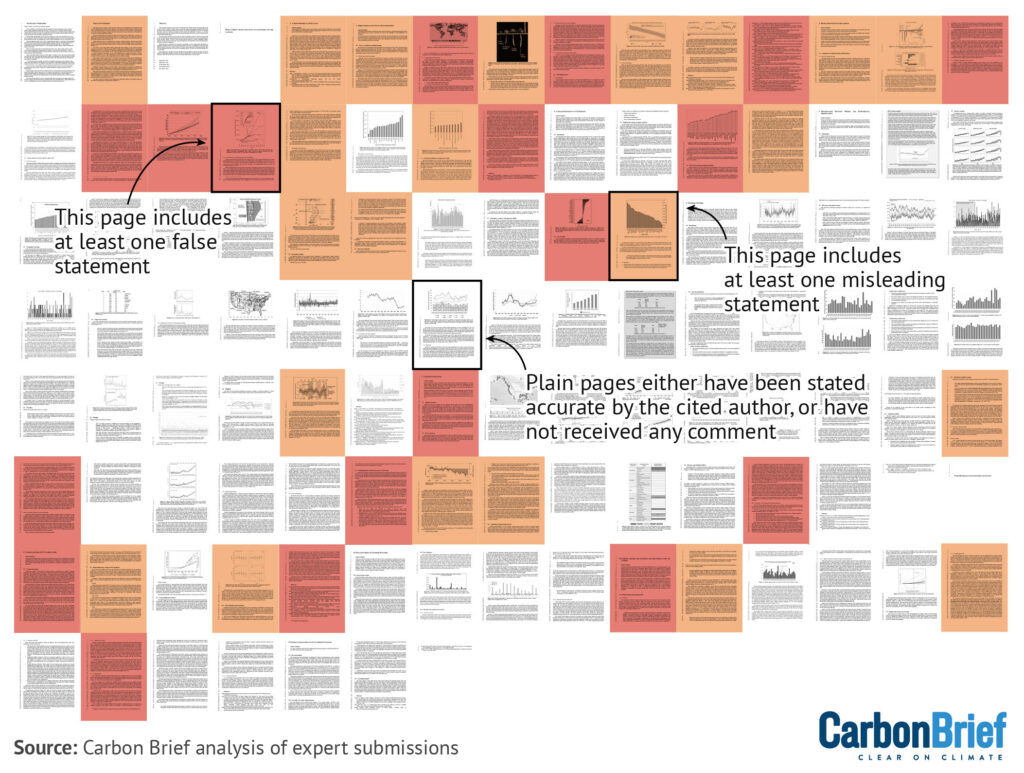
A report commissioned by the US government to justify rolling back climate regulations contains “at least 100 false or misleading statements”, according to a Carbon Brief factcheck involving dozens of leading climate scientists. The report, compiled in two months by five hand-picked researchers, inaccurately claims that “CO2-induced warming might be less damaging economically than commonly believed” and misleadingly states that “excessively aggressive [emissions] mitigation policies could prove more detrimental than beneficial”80
Spotlight
Does Xi Jinping care about climate change?
This week, Carbon Brief unpacks new research on Chinese president Xi Jinping’s policy priorities.
On this day in 2005, Xi Jinping, a local official in eastern China, made an unplanned speech when touring a small village – a rare occurrence in China’s highly-choreographed political culture.
In it, he observed that “lucid waters and lush mountains are mountains of silver and gold” – that is, the environment cannot be sacrificed for the sake of growth.
(The full text of the speech is not available, although Xi discussed the concept in a brief newspaper column – see below – a few days later.)
In a time where most government officials were laser-focused on delivering economic growth, this message was highly unusual.
Forward-thinking on environment
As a local official in the early 2000s, Xi endorsed the concept of “green GDP”, which integrates the value of natural resources and the environment into GDP calculations.
He also penned a regular newspaper column, 22 of which discussed environmental protection – although “climate change” was never mentioned.
This focus carried over to China’s national agenda when Xi became president.
New research from the Asia Society Policy Institute tracked policies in which Xi is reported by state media to have “personally” taken action.
It found that environmental protection is one of six topics in which he is often said to have directly steered policymaking.
Such policies include guidelines to build a “Beautiful China”, the creation of an environmental protection inspection team and the “three-north shelterbelt” afforestation programme.
“It’s important to know what Xi’s priorities are because the top leader wields outsized influence in the Chinese political system,” Neil Thomas, Asia Society Policy Institute fellow and report co-author, told Carbon Brief.
Local policymakers are “more likely” to invest resources in addressing policies they know have Xi’s attention, to increase their chances for promotion, he added.
What about climate and energy?
However, the research noted, climate and energy policies have not been publicised as bearing Xi’s personal touch.
“I think Xi prioritises environmental protection more than climate change because reducing pollution is an issue of social stability,” Thomas said, noting that “smoggy skies and polluted rivers” were more visible and more likely to trigger civil society pushback than gradual temperature increases.
The paper also said topics might not be linked to Xi personally when they are “too technical” or “politically sensitive”.
For example, Xi’s landmark decision for China to achieve carbon neutrality by 2060 is widely reported as having only been made after climate modelling – facilitated by former climate envoy Xie Zhenhua – showed that this goal was achievable.
Prior to this, Xi had never spoken publicly about carbon neutrality.
Prof Alex Wang, a University of California, Los Angeles professor of law not involved in the research, noted that emphasising Xi’s personal attention may signal “top” political priorities, but not necessarily Xi’s “personal interests”.
By not emphasising climate, he said, Xi may be trying to avoid “pushing the system to overprioritise climate to the exclusion of the other priorities”.
There are other ways to know where climate ranks on the policy agenda, Thomas noted:
“Climate watchers should look at what Xi says, what Xi does and what policies Xi authorises in the name of the ‘central committee’. Is Xi talking more about climate? Is Xi establishing institutions and convening meetings that focus on climate? Is climate becoming a more prominent theme in top-level documents?”
Watch, read, listen
TRUMP EFFECT: The Columbia Energy Exchange podcast examined how pressure from US tariffs could affect India’s clean energy transition.
NAMIBIAN ‘DESTRUCTION’: The National Observer investigated the failure to address “human rights abuses and environmental destruction” claims against a Canadian oil company in Namibia.
‘RED AI’: The Network for the Digital Economy and the Environment studied the state of current research on “Red AI”, or the “negative environmental implications of AI”.
Coming up
- 17 August: Bolivian general elections
- 18-29 August: Preparatory talks on the entry into force of the “High Seas Treaty”, New York
- 18-22 August: Y20 Summit, Johannesburg
- 21 August: Advancing the “Africa clean air programme” through Africa-Asia collaboration, Yokohama
Pick of the jobs
- Lancaster Environment Centre, senior research associate: JUST Centre | Salary: £39,355-£45,413. Location: Lancaster, UK
- Environmental Justice Foundation, communications and media officer, Francophone Africa | Salary: XOF600,000-XOF800,000. Location: Dakar, Senegal
- Politico, energy & climate editor | Salary: Unknown. Location: Brussels, Belgium
- EnviroCatalysts, meteorologist | Salary: Unknown. Location: New Delhi, India
DeBriefed is edited by Daisy Dunne. Please send any tips or feedback to debriefed@carbonbrief.org.
This is an online version of Carbon Brief’s weekly DeBriefed email newsletter. Subscribe for free here.
The post DeBriefed 15 August 2025: Raging wildfires; Xi’s priorities; Factchecking the Trump climate report appeared first on Carbon Brief.
DeBriefed 15 August 2025: Raging wildfires; Xi’s priorities; Factchecking the Trump climate report
Greenhouse Gases
Cropped 13 August 2025: Fossil-fuelled bird decline; ‘Deadly’ wildfires; Empty nature fund
We handpick and explain the most important stories at the intersection of climate, land, food and nature over the past fortnight.
This is an online version of Carbon Brief’s fortnightly Cropped email newsletter. Subscribe for free here.
Key developments
‘Deadly’ wildfires
WINE BRAKE: France experienced its “largest wildfire in decades”, which scorched more than 16,000 hectares in the country’s southern Aude region, the Associated Press said. “Gusting winds” fanned the flames, Reuters reported, but local winemakers and mayors also “blam[ed] the loss of vineyards”, which can act as a “natural, moisture-filled brake against wildfires”, for the fire’s rapid spread. It added that thousands of hectares of vineyards were removed in Aude over the past year. Meanwhile, thousands of people were evacuated from “deadly” wildfires in Spain, the Guardian said, with blazes ongoing in other parts of Europe.
MAJOR FIRES: Canada is experiencing its second-worst wildfire season on record, CBC News reported. More than 7.3m hectares burned in 2025, “more than double the 10-year average for this time of year”, the broadcaster said. The past three fire seasons were “among the 10 worst on record”, CBC News added. Dr Mike Flannigan from Thompson Rivers University told the Guardian: “This is our new reality…The warmer it gets, the more fires we see.” Elsewhere, the UK is experiencing a record year for wildfires, with more than 40,000 hectares of land burned so far in 2025, according to Carbon Brief.
-
Sign up to Carbon Brief’s free “Cropped” email newsletter. A fortnightly digest of food, land and nature news and views. Sent to your inbox every other Wednesday.
WESTERN US: The US state of Colorado has recorded one of its largest wildfires in history in recent days, the Guardian said. The fire “charred” more than 43,300 hectares of land and led to the temporary evacuation of 179 inmates from a prison, the newspaper said. In California, a fire broke out “during a heatwave” and burned more than 2,000 hectares before it was contained, the Los Angeles Times reported. BBC News noted: “Wildfires have become more frequent in California, with experts citing climate change as a key factor. Hotter, drier conditions have made fire seasons longer and more destructive.”
FIRE FUNDING: “Worsening fires” in the Brazilian Amazon threaten new rainforest funding proposals due to be announced at the COP30 climate summit later this year, experts told Climate Home News. The new initiatives include the Tropical Forests Forever Facility, which the outlet said “aims to generate a flow of international investment to pay countries annually in proportion to their preserved tropical forests”. The outlet added: “If fires in the Amazon continue to worsen in the years to come, eligibility for funding could be jeopardised, Brazil’s environment ministry acknowledged.”
Farming impacts
OUT OF ORBIT: US president Donald Trump moved to “shut down” two space missions which monitor carbon dioxide and plant health, the Associated Press reported. Ending these NASA missions would “potentially shu[t] off an important source of data for scientists, policymakers and farmers”, the outlet said. Dr David Crisp, a retired NASA scientist, said the missions can detect the “glow” of plant growth, which the outlet noted “helps monitor drought and predict food shortages that can lead to civil unrest and famine”.
FARM EXTREMES: Elsewhere, Reuters said that some farmers are considering “abandoning” a “drought-hit” agricultural area in Hungary as “climate change cuts crop yields and reduces groundwater levels”. Scientists warned that rising temperatures and low rainfall threaten the region’s “agricultural viability”, the newswire added. Meanwhile, the Premium Times in Nigeria said that some farmers are “harvest[ing] crops prematurely” due to flooding fears. A community in the south-eastern state of Imo “has endured recurrent floods, which wash away crops and incomes alike” over the past decade, the newspaper noted.
SECURITY RISKS: Food supply chains in the UK face “escalating threats from climate impacts and the migration they are triggering”, according to a report covered by Business Green. The outlet said that £3bn worth of UK food imports originated from the 20 countries “with the highest numbers of climate-driven displacements” in 2024, based on analysis from the Energy and Climate Intelligence Unit. The analysis highlighted that “climate impacts on food imports pose a threat to UK food security”. Elsewhere, an opinion piece in Dialogue Earth explored how the “role of gender equity in food security remains critically unaddressed”.
Spotlight
Fossil-fuelled bird decline
This week, Carbon Brief covers a new study tracing the impact of fossil-fuelled climate change on tropical birds.
Over the past few years, biologists have recorded sharp declines in bird numbers across tropical rainforests – even in areas untouched by humans – with the cause remaining a mystery.
A new study published this week in Nature Ecology and Evolution could help to shed light on this alarming phenomenon.
The research combined ecological and climate attribution techniques for the first time to trace the fingerprint of fossil-fuelled climate change on declining bird populations.
It found that an increase in heat extremes driven by climate change has caused tropical bird populations to decline by 25-38% in the period 1950-2020, when compared to a world without warming.
In their paper, the authors noted that birds in the tropics could be living close to their “thermal limits”.
Study lead author Dr Maximilian Kotz, a climate scientist at the Barcelona Supercomputing Center in Spain, explained to Carbon Brief:
“High temperature extremes can induce direct mortality in bird populations due to hyperthermia and dehydration. Even when they don’t [kill birds immediately], there’s evidence that this can then affect body condition which, in turn, affects breeding behaviour and success.”
Conservation implications
The findings have “potential ramifications” for commonly proposed conservation strategies, such as increasing the amount of land in the tropics that is protected for nature, the authors said. In their paper, they continued:
“While we do not disagree that these strategies are necessary for abating tropical habitat loss…our research shows there is now an additional urgent need to investigate strategies that can allow for the persistence of tropical species that are vulnerable to heat extremes.”
In some parts of the world, scientists and conservationists are looking into how to protect wildlife from more intense and frequent climate extremes, Kotz said.
He referenced one project in Australia which is working to protect threatened wildlife following periods of extreme heat, drought and bushfires.
Prof Alex Pigot, a biodiversity scientist at University College London (UCL), who was not involved in the research, said the findings reinforced the need to systematically monitor the impact of extreme weather on wildlife. He told Carbon Brief:
“We urgently need to develop early warning systems to be able to anticipate in advance where and when extreme heatwaves and droughts are likely to impact populations – and also rapidly scale up our monitoring of species and ecosystems so that we can reliably detect these effects.”
There is further coverage of this research on Carbon Brief’s website.
News and views
EMPTY CALI FUND: A major voluntary fund for biodiversity remains empty more than five months after its launch, Carbon Brief revealed. The Cali Fund, agreed at the COP16 biodiversity negotiations last year, was set up for companies who rely on nature’s resources to share some of their earnings with the countries where many of these resources originate. Big pharmaceutical companies did not take up on opportunities to commit to contributing to the fund or be involved in its launch in February 2025, emails released to Carbon Brief showed. Just one US biotechnology firm has pledged to contribute to the fund in the future.
LOSING HOPE: Western Australia’s Ningaloo reef – long considered a “hope spot” among the country’s coral reefs for evading major bleaching events – is facing its “worst-ever coral bleaching”, Australia’s ABC News reported. The ocean around Ningaloo has been “abnormally” warm since December, resulting in “unprecedented” bleaching and mortality, a research scientist told the outlet. According to marine ecologist Dr Damian Thomson, “up to 50% of the examined coral was dead in May”, the Sydney Morning Herald said. Thomson told the newspaper: “You realise your children are probably never going to see Ningaloo the way you saw it.”
‘DEVASTATION BILL’: Brazil’s president, Luiz Inácio Lula da Silva, signed a “contentious” environmental bill into law, but “partially vetoed” some of the widely criticised elements, the Financial Times reported. Critics, who dubbed it the “devastation bill”, said it “risked fuelling deforestation and would harm Brazil’s ecological credentials” just months before hosting the COP30 climate summit. The newspaper said: “The leftist leader struck down or altered 63 of 400 provisions in the legislation, which was designed to speed up and modernise environmental licensing for new business and infrastructure developments.” The vetoes need to be approved by congress, “where Lula lacks a majority”, the newspaper noted.
RAINFOREST DRILLING: The EU has advised the Democratic Republic of the Congo (DRC) against allowing oil drilling in a vast stretch of rainforest and peatland that was jointly designated a “green corridor” earlier this year, Climate Home News reported. In May, the DRC announced that it planned to open the conservation area for drilling, the publication said. A spokesperson for the European Commission told Climate Home News that the bloc “fully acknowledges and respects the DRC’s sovereign right to utilise its diverse resources for economic development”, but that it “highlights the fact that green alternatives have facilitated the protection of certain areas”.
NEW PLAN FOR WETLANDS: During the 15th meeting of the Ramsar Convention on Wetlands, held in Zimbabwe from 23 to 31 July, countries agreed on the adoption of a new 10-year strategic plan for conserving and sustainably using the world’s wetlands. Down to Earth reported that 13 resolutions were adopted, including “enhancing monitoring and reporting, capacity building and mobilisation of resources”. During the talks, Zimbabwe’s environment minister announced plans to restore 250,000 hectares of degraded wetlands by 2030 and Saudi Arabia entered the Convention on Wetlands. Panamá will host the next COP on wetlands in July 2028.
MEAT MADNESS: DeSmog covered the details of a 2021 public relations document that revealed how the meat industry is trying to “make beef seem climate-friendly”. The industry “may have enlisted environmental groups to persuade people to ‘feel better’ about eating beef”, the outlet said, based on this document. The strategy was created by a communications agency, MHP Group, and addressed to the Global Roundtable for Sustainable Beef. One of the key messages of the plan was to communicate the “growing momentum in the beef industry to protect and nurture the Earth’s natural resources”. MHP Group did not respond to a request for comment, according to DeSmog.
Watch, read, listen
MAKING WAVES: A livestream of deep-sea “crustaceans, sponges and sea cucumbers” has “captivated” people in Argentina, the New York Times outlined.
BAFFLING BIRDS: The Times explored the backstory to the tens of thousands of “exotic-looking” parakeets found in parks across Britain.
PLANT-BASED POWER: In the Conversation, Prof Paul Behrens outlined how switching to a plant-based diet could help the UK meet its climate and health targets.
MARINE DISCRIMINATION: Nature spoke to a US-based graduate student who co-founded Minorities in Shark Science about her experiences of racism and sexism in the research field.
New science
- Applying biochar – a type of charcoal – to soils each year over a long period of time can have “sustained benefits for crop yield and greenhouse gas mitigation”, according to a Proceedings of the National Academy of Sciences study.
- New research, published in PLOS Climate, found that nearly one-third of highly migratory fish species in the US waters of the Atlantic Ocean have “high” or “very high” vulnerability to climate change, but the majority of species have “some level of resilience and adaptability”.
- A study in Communications Earth & Environment found a “notable greening trend” in China’s wetlands over 2000-23, with an increasing amount of carbon being stored in the plants growing there.
In the diary
- 18-29 August: Second meeting of the preparatory commission for the Agreement on Marine Biological Diversity of Areas beyond National Jurisdiction | New York
- 24-28 August: World Water Week | Online and Stockholm, Sweden
- 26-29 August: Sixth forum of ministers and environment authorities of Asia Pacific | Nadi, Fiji
Cropped is researched and written by Dr Giuliana Viglione, Aruna Chandrasekhar, Daisy Dunne, Orla Dwyer and Yanine Quiroz. Please send tips and feedback to cropped@carbonbrief.org
The post Cropped 13 August 2025: Fossil-fuelled bird decline; ‘Deadly’ wildfires; Empty nature fund appeared first on Carbon Brief.
Cropped 13 August 2025: Fossil-fuelled bird decline; ‘Deadly’ wildfires; Empty nature fund
Greenhouse Gases
Holding the line on climate: EPA
CCL submits a formal comment on EPA’s proposed endangerment finding rollback
By Dana Nuccitelli, CCL Research Manager
On July 29, the EPA proposed to rescind its 2009 endangerment finding that forms the basis of all federal climate pollution regulations.
Without the endangerment finding, the EPA may not be allowed or able to regulate greenhouse gas pollution from sources like power plants or vehicle tailpipes, as they have done for years. News coverage has framed this as a “radical transformation” and a “bid to scrap almost all pollution regulations,” so it has appropriately alarmed many folks in the climate and environment space.
At CCL, we focus our efforts on working with Congress to implement durable climate policies, and so we don’t normally take actions on issues like this that relate to federal agencies or the courts. Other organizations focus their efforts on those branches of the government and are better equipped to spearhead this type of moment, and we appreciate those allies.
But in this case, we did see an opportunity for CCL’s voice — and our focus on Congress — to play a role here. We decided to submit a formal comment on this EPA action for two reasons.
First, this decision could have an immense impact by eliminating every federal regulation of climate pollutants in a worst case scenario. Second, this move relates to our work because the EPA is misinterpreting the text and intent of laws passed by Congress. Our representatives have done their jobs by passing legislation over the past many decades that supports and further codifies the EPA’s mandate to regulate climate pollution. That includes the Clean Air Act, and more recently, the Inflation Reduction Act. We at CCL wanted to support our members of Congress by making these points in a formal comment.
There has been a tremendous public response to this action. In just over one week, the EPA already received over 44,000 public comments on its decision, and the public comment period will remain open for another five weeks, until September 15.
To understand more about the details and potential outcomes of the EPA’s actions, read my article on the subject at Yale Climate Connections, our discussion on CCL Community, and CCL’s formal comment, which represents our entire organization. As our comment concludes,
“In its justifications for rescinding the 2009 endangerment finding, the Reconsideration has misinterpreted the text of the Clean Air Act, Congress’ decadeslong support for the EPA’s mandate to regulate greenhouse gas emissions from motor vehicles and other major sources, and the vast body of peer-reviewed climate science research that documents the increasingly dangerous threats that those emissions pose to Americans’ health and welfare. Because the bases of these justifications are fundamentally flawed, CCL urges the EPA to withdraw its ill-conceived Reconsideration of the 2009 endangerment finding. The EPA has both the authority and the responsibility to act. Americans cannot afford a retreat from science, law, and common sense in the face of a rapidly accelerating climate crisis.”
After the EPA responds to the public comment record and finalizes its decision, this issue will ultimately be decided by the Supreme Court several years from now.
In the meantime, CCL will continue to focus our efforts on areas where we can make the biggest difference in preserving a livable climate. Right now, that involves contacting our members of Congress to urge them to fully fund key climate and energy programs and protect critical work at the National Oceanic and Atmospheric Administration (NOAA), National Aeronautics and Space Administration (NASA), and Department of Energy. We’ve set an ambitious goal of sending 10,000 messages to our members of Congress, so let’s all do what CCL does best and make our voices heard on this critical issue.
This action by the EPA also reminds us that federal regulations are fragile. They tend to change with each new administration coming into the White House. Legislation passed by Congress – especially when done on a bipartisan basis – is much more durable. That’s why CCL’s work, as one of very few organizations engaging in nonpartisan advocacy for long-lasting climate legislation, is so critical.
That’s especially true right now when we’re seeing the Trump administration slam shut every executive branch door to addressing climate change. We need Congress to step up now more than ever to implement durable solutions like funding key climate and energy programs, negotiating a new bipartisan comprehensive permitting reform bill, implementing healthy forest solutions like the Fix Our Forests Act, and advancing conversations about policies to put a price on carbon pollution. Those are the kinds of effective, durable, bipartisan climate solutions that CCL is uniquely poised to help become law and make a real difference in preserving a livable climate.
For other examples of how CCL is using our grassroots power to help ensure that Congress stays effective on climate in this political landscape, see our full “Holding the Line on Climate” blog series.
The post Holding the line on climate: EPA appeared first on Citizens' Climate Lobby.
-
Climate Change2 years ago
Spanish-language misinformation on renewable energy spreads online, report shows
-
Climate Change Videos2 years ago
The toxic gas flares fuelling Nigeria’s climate change – BBC News
-

 Greenhouse Gases1 year ago
Greenhouse Gases1 year ago嘉宾来稿:满足中国增长的用电需求 光伏加储能“比新建煤电更实惠”
-

 Climate Change1 year ago
Climate Change1 year ago嘉宾来稿:满足中国增长的用电需求 光伏加储能“比新建煤电更实惠”
-

 Carbon Footprint1 year ago
Carbon Footprint1 year agoUS SEC’s Climate Disclosure Rules Spur Renewed Interest in Carbon Credits
-
Climate Change2 years ago
Why airlines are perfect targets for anti-greenwashing legal action
-
Climate Change Videos2 years ago
The toxic gas flares fuelling Nigeria’s climate change – BBC News
-
Climate Change2 years ago
Some firms unaware of England’s new single-use plastic ban

